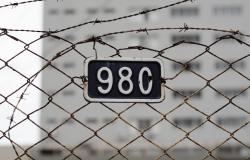Slavery and the U.S. Prison System

This is part of a forthcoming Global Policy e-book on modern slavery. Contributions from leading experts highlighting practical and theoretical issues surrounding the persistence of slavery, human trafficking and forced labour are being serialised here over the coming months.
With roots in the racial slavery of the Atlantic world, the criminal justice system in the U.S. presents a clear case study in modern slavery. Each historical period since the end of the American Civil War has contributed to a massive system of control, to the point that the U.S. now has 2.27 million people behind bars, with an additional 5 million people under community supervision of some kind. Most of the system’s expansion has come since 1980, reaching a high point in 2009, and has declined 7.3 percent since then. But despite being at its lowest point in twenty years, the U.S. rate of incarceration remains by far the highest in the world. The degree to which the U.S. is out of pace with the rest of the world’s humanity is that a full quarter of all prisoners worldwide are held in U.S. jails and prisons, and the U.S. incarceration rate of 639 per 100,000 people is 5-10 times higher than other industrialized democracies. Sixty-five percent of the total U.S. prison population is black, despite black people comprising only 14.6 percent of American society in 2019. Because non-black people of color are represented in the prison population commensurate with their demographic presence in U.S. society, the criminal justice system bears a specifically antiblack character that directly indicts its place within the U.S.’s longstanding status as a slaveholding society.
These dramatic increases in the numbers of people brought into the criminal justice system, and how long they remain under its control, are the result of aggressive policymaking over the past forty years to enhance punitiveness at every stage in the criminal justice process:
The dawn of mass incarceration in the 1980s opened a period of attenuated lethality in black communities that was made to appear to be the result of self-destructive forces internal to these communities—drug addiction, gang violence, worklessness—when in fact these forces were expressions of state power. Gary Webb’s famous investigation revealed that the CIA was operating a gun-running and drug-smuggling operation that brought guns to the Nicaraguan contras that the U.S. was using to destabilize the popular government in that country, while bringing cocaine into the U.S. and funneling it to street-level dealers with access to black inner-city neighborhoods. The history of black street gangs is part of the afterlife of COINTELPRO, the FBI’s counter-intelligence program that actively sabotaged black social movement throughout the long civil rights era. Bobby Lavender, one of the founders of the Bloods in Los Angeles, explained that the COINTELPRO assassinations of black leaders, and the terrorizing of rank-and-file civil rights activists, left an organizational vacuum in many communities that youth like him filled with their “own brand of leadership.” COINTELPRO established a pattern of law enforcement interference and sabotage of black self-determination, including gang truces, from the 1970s through to the present. The backdrop to drug and gang warfare was the dramatic restructuring of the post-industrial welfare state. Deindustrialization has meant the loss of stable working-class jobs and changes in welfare policy that have contributed to soaring precarity for vast numbers of people as the cost of living exceeds people’s ability to pay. The convergence of these historical forces has made black people structurally vulnerable to being warehoused in cages.
More than simply a policy issue, however, mass incarceration is expressive of a culture of politics ready and willing to sacrifice black interests, that generally views black people fearfully and as problems to be controlled, and is in fee to the antiblack violence in which the society remains grounded. The dramatic transformations in U.S. society since the 1980s were all made possible by racist mythologies about black familial pathology: fear of black crime, black sex, black mothers, black kids, black music, and black spaces. Carol Anderson explains it in terms of white rage. Writing after the uprisings in Ferguson, MO following the killing of Michael Brown, Anderson says, “[i]t goes virtually unnoticed, however, because white rage doesn’t have to take to the streets and face rubber bullets to be heard. Instead, white rage carries an aura of respectability and has access to the courts, police, legislatures and governors, who cast its efforts as noble, though they are actually driven by the most ignoble motivations.”
In recent years, a burgeoning bi-partisan consensus in favor of criminal justice reform has emerged to give hope to families and organizations that have been pushing for change for decades. This development has recently amplified calls for prison abolition and the defunding of police. If we apply Anderson’s analysis of white rage, then not only were the ensemble of carceral policies of the past half century created to sacrifice black needs, advance white interests, and ameliorate white rage, but moreover, it would be irrational to expect the potential policy reversals underway now to do anything but advance this essential parasitic structure, albeit in refined ways. When we examine more closely the relationship between the deeply entrenched culture of slaveholding and post-Emancipation criminal law, such analytical and political skepticism proves warranted.
As Frederick Douglass explained in W. E. B. DuBois’ Black Reconstruction, the Civil War was begun “in the interests of slavery on both sides. The South was fighting to take slavery out of the Union, and the North was fighting to keep it in the Union; the South fighting to get it beyond the limits of the United States Constitution, and the North fighting for the old guarantees—both despising the Negro, both insulting the Negro.” Preserving the Union meant preserving slavery, but as DuBois revealed in his seminal study, the collective response of the enslaved forced the war to become a war to end slavery. Slave emancipation, then, was an expression of black self-determination, opportunistically forced upon the whole of the country during the exigencies of war. From the point of view of the enslaved, the conflict within the slaveholding class (North vs. South) produced a brief hiatus in the centuries-old war against their white oppressors that they strategically wielded to end the formal institution of slavery. It was the ultimate heist: while their adversaries
The ex-slaves were powerless, however, to withstand slavery’s transmutation in the war’s aftermath. Close reading of the Thirteenth Amendment reveals that it does not actually abolish slavery, but instead relocates it into the domain of the criminal justice system. Debates about mass incarceration today point to this feature of the Thirteenth Amendment and misconstrue the clause stating that criminal convicts can be enslaved as a “loophole” that has been improperly exploited to produce the gross injustice of industrialized punishment today. This interpretation is incorrect. The clause in question is a design feature, not a design flaw, historically consistent with the original agenda of the war to extend, not end, black unfreedom. Since criminalization is first and foremost a political-symbolic tool, it refers not to individual behavior but rather to a racialized construct of human worth. The Amendment’s authors knew exactly who they had in mind with the penal servitude clause because this framework of black dangerousness and lawlessness had long informed the culture of slaveholding. While otherwise geared to disavow black humanity, slave law recognized slave agency only to ascribe criminal liability. In short, slavery relied on the notion that black people are only one kind of human being: the criminal kind. As such, the Thirteenth Amendment oversees the reiteration of democracy’s basis in social captivity—no plantations, no auction blocks, no laws, no prisons necessary.
If blackness is criminalized a priori, irrespective of whether blacks break the law or not, then the stain of enslavement rests on all black people, imprisoned or not. Far from the end of slavery, therefore, the Thirteenth Amendment marks the continuation of slaveholding culture despite the fact that no one is legally held in bondage as a slave: slavery without slaves. The post-Emancipation era saw Reconstruction undermined in part through the institutionalization of black criminality by means of the Black Codes, convict leasing, sharecropping, and lynching. With these developments in “penal democracy” the state became a dealer in crime: leasing convict labor proved profitable for private enterprise, abetted the expansion of state authority, promoted white supremacy, and disciplined free workers of all races toiling in the mines, fields, and factories of early twentieth century America. By twentieth century’s close, this recipe for combining profit and punishment would come to be known as the prison industrial complex. Private industry has found prison expansion hugely profitable, from Wall Street bond financing to the complex of industries necessary for prison construction and operation. Private for-profit prisons, beginning in the mid-1980s, have always held a small percentage of the overall inmate population, but exert an out-sized influence on policy. For instance, after Corrections Corporation of America (CCA) saw their stock price plummet from $150 a share to 19 cents between 1998 and 2000 due to exposés of bad practices at their facilities, they successfully lobbied the Bush Administration in the immediate aftermath of the events of September 11, 2001. Bush’s “war on terror” thus became, on the domestic front, a war on immigrants through new detention policies. Today only eight percent of the overall state and federal incarcerated population is held in private prisons, but eighty-one percent of detained immigrants are locked up in privately run facilities.
The U.S. government regularly condemns other nations’ incarceration practices on the very same grounds that the international community alleges human rights violations against American criminal justice. A series of court decisions since the 1980s contesting inadequacies in medical care for prisoners, visitation rights, prisoners’ access to reading materials and law libraries, use of force, and conditions of confinement, have steadily eviscerated the substance of the Eighth Amendment’s protections against “cruel and unusual” punishment. These decisions winnow the legal persona of prisoners to the point that they are merely caged bodies, not human beings. In so doing, the courts demonstrate the continuities between the slavocracy and our present period of modern-day slavery. Antebellum slave codes provided for the slave’s basic needs of food, shelter, and security—a slave was a mere body, in other words, devoid of a legal persona that would warrant protection. The law of slavery also featured prohibitions against excessive punishments and willfully or maliciously killing a slave, except when the slave died resisting a master or when “dying under moderate correction.” As Colin Dayan explains, to style the “correction” of a slave that causes death “moderate” is to guarantee tyranny, while the attempt to curb torture hides law’s brutality behind vague standards of “humane” care. In Madrid v. Gomez, for example, the court found the most heinous practices of the prison unconstitutional (e.g., forced gladiator fights, burning an inmate’s skin off with scalding water, caging naked prisoners outdoors in freezing temperatures), while decreeing that the condition of solitary confinement itself remains within the limits of permissible pain, despite the wealth of evidence to the contrary. Each of the Supreme Court’s seven Eighth Amendment decisions between 1976 and 1994 were cited by the Bush Administration’s torture memos as laying the legal framework for the treatment of prisoners at Abu Ghraib, Guantanamo, and other as-yet-unnamed detention sites around the world.
In the final analysis, the U.S. prison system as a case study in modern slavery reminds us that mass incarceration is diagnostic of the indefatigable black freedom movement across the eras. General non-submission to the antiblack terms of slaveholding society is the prerogative of the fugitive slave, the maroon, the freedom fighter. Black resistance includes the tradition of inmate organizing, which produced a prisoners’ labor union coming out of the civil rights era, and in recent years has led to a number of state-wide and nation-wide labor strikes by inmates. The Thirteenth Amendment makes it permissible to force inmates to work for no pay, and the U.S. tax code does not classify prison labor as employment. While pay rates vary widely by state and job, the average minimum wage is $0.93 per day. The fact that most prison labor does not translate into improved living conditions after release, because the kind of work that inmates perform inside is typically unavailable to them outside prison in the U.S. marketplace, exposes rehabilitation as mere pretense. Since prison labor serves no rehabilitative function, and it does not, in the main, generate profits for prison industries, its purpose is simply punishment. Moreover, precisely because work assignments foremost serve the prison administration’s efforts to maintain control over the inmate population, most prisoners are in fact idle most of the time.
Prison labor, and the collective actions by prisoners to exert control over it, exposes the political nature of imprisonment and the true meaning of enslavement. Although slaves commonly worked and collectively produced the surplus value on which the wealth of the West is based, labor exploitation was never essential to slavery. The essence of the slave was to serve as a fungible human object, to be useful for any purpose the master, or slaveholding society, could conjure. Today, slave fungibility means that black people in the U.S. are more desireable idled in cages than they are as exploited labor anywhere in the global marketplace, behind prison walls or beyond. In this way, fungible blackness enabled the two leading private prison corporations, CCA and Geo, to convert to real estate investment trusts (REIT) for tax purposes, arguing that they are in the property business, a move that has paid off with increased attention from investors, including $2.2 million from the Gates Foundation. Prisons thus become a kind of hedge fund, with the incarcerated as the fungible portfolio by which assets are mobilized to attract further investment and greater returns, not unlike Atlantic slavery wherein the enslaved underwrote the entire finance culture—the bank, stock, credit, insurance, and loan-driven money forms of value—that drove the cycle of capital accumulation that has produced the global capitalist system as we know it today. Work stoppages by prisoners, therefore, are modest attempts at de-linking this chain of accumulation sponsored, in part, by their own captive bodies. The ability to exercise choice and self-determination even while on lockdown, and to use these capacities to forge relations based on common humanity, is an expression of marronage and black self-determination against modern-day slavery.
During the later years of the antebellum slavocracy, the courts not infrequently considered this question of whether slaves could themselves choose to be free or not. In Bailey v. Poindexter’s Executor, John Lewis Poindexter’s heirs contested the stipulation in his will which stated that upon his death his slaves should have their choice of being emancipated or sold publicly. The Virginia Supreme Court of Appeals ultimately found in 1858 that slaves have no legal capacity to choose to be free and ordered Poindexter’s slaves to become the property of his heirs. Slaveholding culture’s attempt to delimit black capacity to choose freedom casts a certain light on why the U.S. has been releasing some of its longest serving political prisoners from the civil rights era. The primary work of counter-insurgency against black social movement has been accomplished after locking up activists for decades: today’s younger generations have been effectively estranged from their elders, fractures deepened, slavery’s natal alienation extended. The repeated appeals and rejected parole petitions of the political prisoner, over and over again, unfold in a manner similar to how slave law was preoccupied for decades with the specific question of black capacity to choose freedom. The incarcerated black activist is almost always a model inmate, fulfilling and exceeding all requirements for parole, forcing the prison to continually defer fulfilling its own rules. In both instances, the law grapples with the problem that it creates: how to justify depriving the slave of the volition to choose freedom even when the law itself grants this choice.
Policing and prisons are inseparable parts of the same structure of modern slavery, and the increasing objections to mass incarceration and U.S. society’s ubiquitous police violence is not unrelated to eighteenth and nineteenth century abolitionism. More often than not, white abolitionists sought to save black people from slavery’s horror, or at least save themselves from slaveholding culture’s decadence. Abolition as self-preservation was a response to the heavy material and moral toll exacted by black resistance; in turn, abolition construed blacks as docile and helpless victims in order to imagine the white man’s burden as savior and martyr. Despite the ceaseless struggle led by black families and communities against state violence in all of its myriad forms, widespread support today among non-blacks for ending mass incarceration turns on the race-neutral figure of the non-violent drug offender, defined against the violent offender who is always imagined as black. Likewise, the widespread embrace of George Floyd as the symbol of police violence (rather than the litany of alternate examples) is undoubtedly connected to the imagery of a helpless black man dying under a white man’s knee as he repeatedly pleads “sir, sir, officer, officer…,” an image that recirculates the popular eighteenth century abolitionist image of the supplicant slave’s plea, “am I not a man and a brother?” These dimensions of today’s abolitionism underscore the status of contemporary criminal justice as a quintessential case study in modern-day slavery.
Tryon P. Woods teaches Crime & Justice Studies at the University of Massachusetts, Dartmouth and Black Studies at Providence College. He is the author of Blackhood Against the Police Power: Punishment and Disavowal in the “Post-Racial” Era (Michigan State 2019) and co-editor of Conceptual Aphasia in Black: Displacing Racial Formation (Lexington 2016) and On Marronage: Ethical Confrontations with Antiblackness (Africa World Press 2015).
Photo by Isabella Mendes from Pexels


